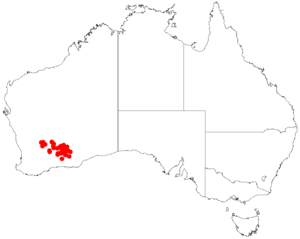Prostanthera incurvata facts for kids
Quick facts for kids Prostanthera incurvata |
|
|---|---|
| Scientific classification | |
| Genus: |
Prostanthera
|
| Species: |
incurvata
|
 |
|
| Occurrence data from AVH | |
The Prostanthera incurvata is a type of flowering plant. It belongs to the Lamiaceae family, which includes mints! This plant is special because it only grows in the inland parts of Western Australia. We call plants that only grow in one specific area "endemic." It's a small bush that stands up straight. It has branches with tiny hairs. Its leaves are long and narrow, a bit like an egg shape, and they are often found closer to the ends of the branches. Its flowers can be pink, red, or sometimes yellow.
What Does It Look Like?
Prostanthera incurvata is a bush that grows upright and spreads out. It usually reaches a height of about 0.4 to 1.5 meters (about 1.3 to 5 feet). Its branches are covered in small hairs.
Its leaves are usually grouped together near the ends of the branches. They are narrow and shaped like an oblong or a narrow egg, with the narrower part at the bottom. Each leaf is about 5 to 10.5 millimeters long and 0.8 to 1.2 millimeters wide. They are also "sessile," which means they attach directly to the stem without a small stalk.
The flowers grow one by one in the "leaf axils." This is the spot where a leaf joins the stem, usually near the ends of the small branches. Each flower sits on a tiny stalk called a "pedicel," which is about 0.8 to 1.5 millimeters long.
The green "sepals" are like small leaves that protect the flower bud. They are 6 to 8 millimeters long and form a tube about 4 to 5 millimeters long. This tube has two small parts, or "lobes," at the top. These lobes are about 2 millimeters long and 3.5 to 4 millimeters wide.
The "petals" are the colorful parts of the flower. They are pink to red, but sometimes they can be yellow. They are 15 to 20 millimeters long and form a tube about 10 millimeters long. The bottom part of this petal tube has three lobes. The middle lobe is shaped like a wide egg and is curved inwards, about 3 to 3.5 millimeters long. The two side lobes are 2 to 2.5 millimeters long. The top part of the petal tube is about 3 millimeters long and has a small dip or "notch" in the middle, about 1 to 1.5 millimeters deep. This plant usually flowers in April, or from August to October.
How It Got Its Name
The Prostanthera incurvata was first officially described in 1987. This means it was given its scientific name and details by a scientist named Barry Conn. He wrote about it in a scientific paper called the Journal of the Adelaide Botanic Gardens. He studied samples of the plant that were found near a place called Lake Cowan.
Where It Lives
This mintbush sometimes grows in areas with "low woodland," which means forests with smaller trees. It has been found in different natural areas of Western Australia. These areas include the Avon Wheatbelt, Coolgardie, and Mallee regions.
Is It Safe?
The Government of Western Australia's Department of Parks and Wildlife says that Prostanthera incurvata is "not threatened." This means there are enough of these plants in the wild, and they are not currently in danger of disappearing.

